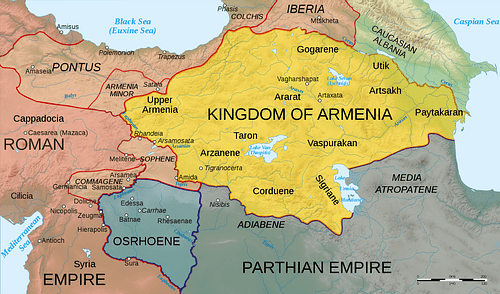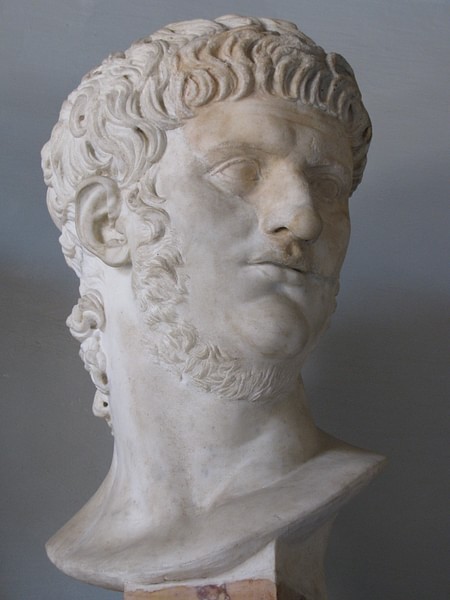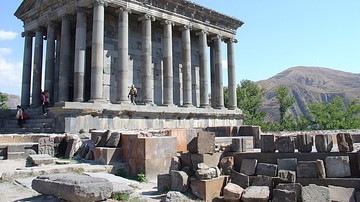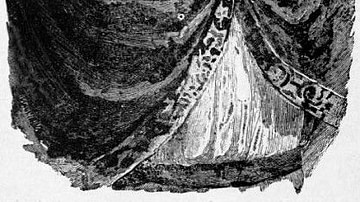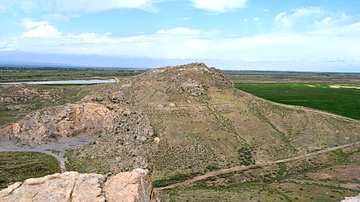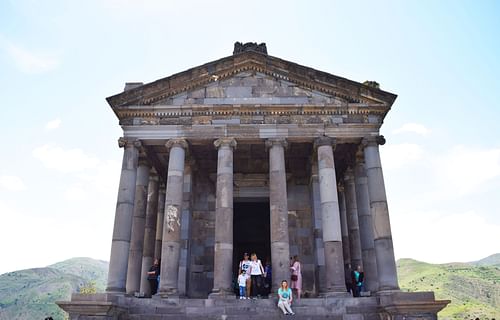
Tiridates I (Trdat I) ruled as the king of Armenia from 63 to either 75 or 88 CE). Considered the founder of the Arsacid dynasty proper, his reign got off to a rocky start with invasions from Rome and Parthia but, once crowned in a lavish ceremony in Rome conducted by Nero himself, the Armenian king would rule for a relatively peaceful and highly prosperous two decades. When exactly his reign ended is disputed due to conflicting ancient sources, but he was (probably) succeeded by his son Sanatruk II who continued with his father's success in balancing Armenia on the diplomatic tightrope it seemed destined to forever occupy between the region's two superpowers.
Succession
Tiridates I of Armenia was the brother of the Parthian king Vologases I (aka Vagharsh, r. c. 51- up to 80 CE, dates disputed) who invaded Armenia in 52 CE for the specific purpose of setting Tiridates on the throne. The Roman Empire was not, though, content to passively permit Parthia into what they considered a buffer zone between the two great powers. Further, an embassy arrived in Rome which represented the pro-Roman faction in Armenia and they asked for direct assistance. Consequently, Roman emperor Nero (r. 54-68 CE) sent an army under his best general Gnaeus Domitius Corbulo in 54 CE to restore Roman influence in the region.
First, Corbulo was given the task of securing both Syria and the small kingdom of Sophene (Dsopk) to beef up Rome's presence in the region and remind Parthia who they were up against. Then, when Parthia declared Armenia a vassal state in 58 CE, Corbulo moved northwards and attacked Armenia itself. By the time the Romans arrived in Tiridates' kingdom, Vologases had been forced to withdraw to deal with internal troubles in Parthia but Tiridates remained at the Armenian capital of Artaxata (Artashat). Tiridates was actually supported by most of the Armenian people who were more sympathetic to Parthia than to Rome for historical and cultural reasons.
Corbulo proved again to be a very capable field commander and with logistical support from Roman ships on the Black Sea, he took and destroyed the two most important cites - Artaxata and Tigranocerta. By 60 CE he could claim to rule over all of the kingdom of Armenia and Tiridates was forced to flee back to his brother in Parthia. In the same year, Tigranes V, who had impressive royal connections being the grandson of Herod the Great, was set on the throne as a pro-Roman monarch, but he would only last until the Parthians sent an army to besiege him in what was left of Tigranocerta. Thereafter, Tigranes disappears from the pages of history after the briefest of cameo appearances in the Armenian king lists.
In 62 CE Parthia won victory against a Roman army (significantly, perhaps, no longer commanded by Corbulo), but in 63 CE the Romans and Corbulo returned and their threat was sufficient for the Treaty of Rhandia to be drawn up (named after the site in western Armenia). It was now agreed that Parthia had the right to nominate Armenian kings, Rome the right to crown them, and both powers would rule equally over Armenia with the king as their representative. Nero was thus given the privilege of crowning Tiridates in Rome in a lavish spectacle that did much to show the power and global reach of the Roman Empire.
The Coronation of Tiridates
In 66 CE, then, Tiridates symbolically presented his crown to an effigy of Nero and then travelled to the great city of Rome to receive it back again from the hands of the emperor. Taking a land route, an impressive entourage, which included the soon-to-be king's wife (wearing a golden helmet and face mask instead of a veil), his children, extended family and 3,000 courtiers, nobles, priests and bodyguards from Armenia, Parthia and Rome, plodded westwards. When Nero had offered to meet the travel expenses he had perhaps not imagined quite such a guest list. It was no surprise either that when the whole troupe arrived in Naples after nine months on the road, they were late. A round of gladiator and athletic games opened the festivities before the actual coronation in the Forum of Rome. There, kneeling before the emperor, Tiridates had to recite what would become the familiar eastern formula of submission:
Master…I have come to thee, my god, to worship thee as I do Mithras. The destiny thou spinnest for me shall be mine, for thou art my Fortune and my Fate. (Payaslian, 29)
Nero replied:
You have done well by coming here to enjoy my presence in person. What your father has not left to you and what your brothers did not preserve for you, I do accord to you, and I make you King of Armenia, so that you, as well as they, may know that I have the power to take away and to grant kingdoms. (Kurkjian, 78)
The king was then crowned and allowed to sit on a throne next to Nero, albeit a slightly lower one than the Roman emperor's. The celebrations then continued in the Theatre of Pompey which Nero, true to form, had decked out completely in glittering gold and Tyrian purple canopies as a flamboyant imperial bonus. The Romans loved a spectacle and Tiridates' coronation certainly gave them one; indeed, thereafter, the day of the celebration carried the epithet “golden”. When the party was over Nero gave Tiridates a parting gift of 2 million sesterces and sent him on his way to rebuild Armenia.
A Prosperous Reign
With such a flurry of ancient sources gushing over Tiridates' coronation, it is rather disappointing that we know so little of the rest of his reign. We do know that the Romans next placed a handful of garrisons in the area to ensure the Treaty of Rhandia was adhered to but generally, there was, as planned by all three sides, a sustained period of peace.
The kingdom's prosperity, based on natural resources, agriculture and trade permitted Tiridates to build a new summer residence at Garni. A magnificent fortified complex built from white limestone, it boasted all the amenities of any palace anywhere in the Classical world. There were Roman baths, gardens, courtyards, mosaic-floored rooms and even a full-scale Roman temple for the king when in residence (which still stands today). An inscription from Garni reveals that Tiridates was now calling himself “the Sun” and “Supreme Ruler of Armenia”. Other notable projects of the period included the rebuilding of Artaxata after its destruction by Corbulo and which Roman writers record was renamed Neronia in honour of the king's great benefactor. A temple north of that city was dedicated to the god Tir. Finally, a number of estates were set aside by the king for pilgrims to pay homage to some of his relatives, after all, he was the Sun god Helios now. The agricultural production and consequent tribute from these sites also gave a handy boost to the royal treasury.
Notwithstanding the good times, there would soon be a reminder of Armenia's status as a client kingdom. Roman emperor Vespasian (r. 69-79 CE) made absolutely sure that no more territories in the region would fall to the Parthian ruling dynasty by annexing the kingdoms of Commagene and Lesser Armenia in 72 CE. In the same year (or perhaps the next) the nomadic Alani people temporarily invaded Armenia but Tiridates remained unscathed. There was perhaps also an Armenian invasion of Iberia (modern Georgia) but details are lacking in the now silent historical record.
Successor & Arsacid Dynasty
Tiridates I is considered the founder of the long-ruling Arsacid dynasty (Arshakuni) which would last until 428 CE. The dynasty had actually had its first king in 12 CE with the succession of Vonon (Vonones) but the instability of the Armenian throne and many short-reigning monarchs after Vonon has resulted in some historians taking Tiridates, with his more stable regime and that of his successors, as the true founder of the dynasty. When Tiridates died he was (probably) succeeded by his son Sanatruk II who would rule until 109 CE.
This article was made possible with generous support from the National Association for Armenian Studies and Research and the Knights of Vartan Fund for Armenian Studies.
